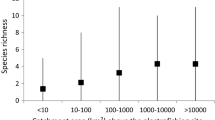Abstract
Increased sewage pollution in the Little Patuxent River, Maryland, from 1958 to 1967, brought about changes in fish migration, in abundance of resident species, and in the fish community in the stream. The upstream migration of white catfish, white perch, white sucker, and northern redhorse was apparently adversely affected by the increased sewage pollution. The downstream ranges and abundance of resident smallmouth bass and northern hog sucker decreased as did the upstream ranges and abundance of black crappie. Brown bullhead, golden shiner, redbreast sunfish, and bluegill showed different degrees of changes in abundance without reduction in their distribution ranges. Number of species and fish abundance decreased drastically in the area immediately below the chlorinated sewage effluents. Downstream, in the organically enriched areas, the fish community composition changed although there were no changes in number of species.
Similar content being viewed by others
Literature Cited
AMERICAN FISHERIES SOCIETY, 1960. A list of common and scientific names of fishes from the United States and Canada. Second Edition,Amer. Fish. Soc., Spec. Pub. No. 2: 102 p.
BURLINGTON, R. F. 1962. Quantitative Biological Assessment of Pollution.Jour. WPCF 34(2):179–183.
DOUDOROFF, P., aND M. KATZ. 1950. Critical review of literature on the toxicity of industrial wastes and their components to fish. 1. Alkalies, acids and inorganic gases.Sewage and Industrial Wastes 22(11): 1432–1458.
KATZ, M., AND A. R. GAUFIN. 1952. The effects of sewage pollution on the fish population of a midwestern stream.Trans. Amer. Fish. Soc. (82): 156–165.
LLOYD, R., AND D. H. M. JORDAN. 1963. Predicted and observed toxicities of several sewage effluents to rainbow trout.J. Proc. Insti. Sewage Pur. (2): 167–173.
MANSUETI, R. J. 1950. An ecological and distributional study of the fishes of the Patuxent River watershed, Maryland. M.S. Thesis. Univ. of Maryland. 181 p.
—. 1961. Movements, reproduction and mortality of the white perch,Roccus americanus, in the Patuxent estuary, Maryland.Chesapeake Sci. 2(3–4): 142–205.
MERKENS, J. C. 1958. Studies on the toxicity of chlorine and chloramines to the rainbow trout.Water Waste Treatment J. 7: 150.
McKEE, J. E., AND H. W. WOLF. 1963. Water Quality Criteria. 2nd Ed. California State Water Quality Control Board. Publ. No. 3-A. 548 p.
SANDERSON, A. E. 1958. The Little Patuxent River Fishery. Maryland Department of Game and Inland Fish. Mimeo, 8 p.
SCHWARTZ, F. J. 1965. The age, growth, and length-weight relationship of the Patuxent River, Maryland ictalurid white catfish,Ictalurus catus.Chesapeake Sci. 6(4): 226–229.
TSAI, C. 1968. Effects of chlorinated sewage effluents on fishes in upper Patuxent River, Maryland.Chesapeake Sci. 9(2): 83–93.
WEBER, E. C. 1958. Little Patuxent River Survey. Maryland Department of Health. Mimeo. 19 p.
Author information
Authors and Affiliations
Additional information
Contribution No. 407, Natural Resources Institute, University of Maryland.
Rights and permissions
About this article
Cite this article
Tsai, CF. Changes in fish populations and migration in relation to increased sewage pollution in little Patuxent River, Maryland. Chesapeake Science 11, 34–41 (1970). https://doi.org/10.2307/1351340
Issue Date:
DOI: https://doi.org/10.2307/1351340




